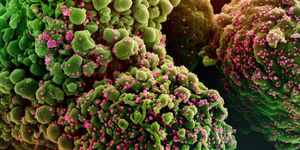Making Genetic Engineering at the Chromosome Level Possible
Chromosomes can vary in length and size, but they usually carry thousands of base pairs of DNA. While scientists have successfully edited the genomes of many creatures, most of those edits have been fairly small when considering the size of a whole chromosome. CRISPR has helped advance the technique, however, and last year, researchers announced the development of a tool that could insert up to 5,000 base pairs into the genome of human cells. Large gene fusions and translocations are known to cause some human diseases. The ultimate goal for the clinic would be treating human disorders that involve large sections of DNA or structural changes to the genome.
Now scientists have successfully made genetic changes at the chromosomal level in a mouse model. The work has been reported in Science.
Chromosome rearrangements can happen naturally; there are about 3.2 to 3.5 of those rearrangements in rodents every million years, while primates have around 1.6, noted co-first study author Li Zhikun, a researcher in the Chinese Academy of Sciences (CAS) Institute of Zoology. Mice in the research lab have maintained their 40 chromosomes throughout 100 years of inbreeding, Li added.
Those rare chromosome fusion events could have a massive effect, said Li. The 1.6 changes that occurred in primates may have made us human; gorillas carry two different chromosomes that are fused in people.
Synthetic biologists have been trying to engineer complex multicellular life forms that carry designer DNA sequences. Engineering changes on the chromosomal level could help us understand how to repair malformations in chromosomes. Up until now, those kinds of genetic changes have only been possible in yeast cells, which is described in the video.
Haploid mouse stem cells carry only one set of chromosomes that often lose genetic imprinting found in diploid cells, which tells a cell which gene should be expressed out of two copies that are carried. The research team found that when three imprinted regions were removed, a stable imprinting pattern could be created in the cells.
The researchers were able to fuse chromosome 1 and 2, as well as chromosome 4 and 5, in haploid embryonic mouse stem cells. The differentiation of stem cells that were altered in this way was unaffected. But, during development, the fusion of chromosomes 1 and 2 caused mitosis to halt and those embryos died. The fusion of chromosomes 4 and 5 was not as detrimental, however, and these animals survived. They did exhibit a reduction in fertility, but were also able to pass down the fused chromosome to offspring.
This study has shown that it may be possible to engineer chromosomes in mammals.
"Some engineering mice showed abnormal behavior and postnatal overgrowth, whereas others exhibited decreased fecundity, suggesting that although the change of genetic information was limited, fusion of animal chromosomes could have profound effects," Li said. "Using an imprint fixed haploid embryonic stem cell platform and gene editing in a laboratory mouse model, we experimentally demonstrated that the chromosomal rearrangement event is the driving force behind species evolution and important for reproductive isolation, providing a potential route for large-scale engineering of DNA in mammals."
Sources: Chinese Academy of Sciences, Science









